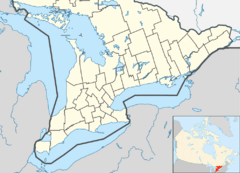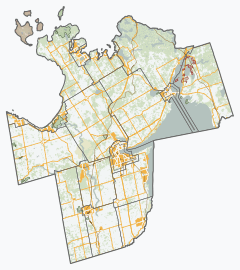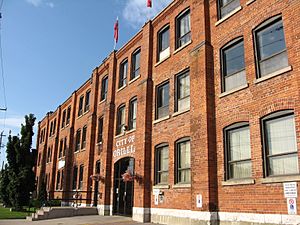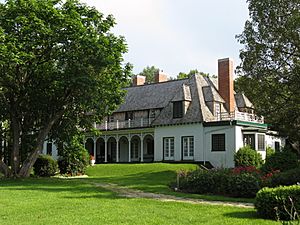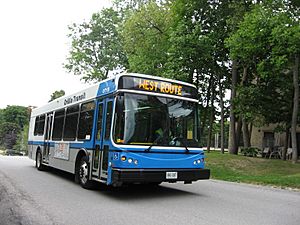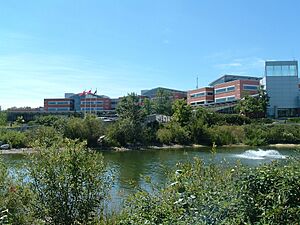Orillia facts for kids
Quick facts for kids
Orillia
|
|||
|---|---|---|---|
| City of Orillia | |||
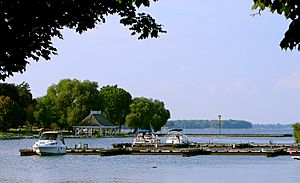
Waterfront of Orillia
|
|||
|
|||
| Nickname(s):
The Sunshine City
|
|||
| Country | Canada | ||
| Province | Ontario | ||
| Incorporation | 1867 (Village) | ||
| Incorporation | 1875 (Town) | ||
| Incorporation | 1969 (City) | ||
| Area | |||
| • Land | 28.53 km2 (11.02 sq mi) | ||
| Elevation | 219.50 m (720.14 ft) | ||
| Population
(2021)
|
|||
| • Total | 33,411 | ||
| • Density | 1,171.1/km2 (3,033/sq mi) | ||
| Time zone | UTC−05:00 (EST) | ||
| • Summer (DST) | UTC−04:00 (EDT) | ||
| Forward Sortation Area |
L3V
|
||
| Area code(s) | 705 / 249 | ||
Orillia is a city in Ontario, Canada. It is about 30 km (18 miles) northeast of Barrie in Simcoe County. The city is located where Lake Couchiching and Lake Simcoe meet. Even though it is inside Simcoe County, Orillia is a special kind of city called a single-tier municipality. This means it manages its own local government services. It is part of the Huronia area in Central Ontario. In 2021, about 33,411 people lived there.
Orillia became a village in 1867. But people have lived in this area for thousands of years. Archaeologists have found signs that the Huron and Iroquois peoples fished here over 4,000 years ago. They also found places used by Aboriginal peoples for hundreds of years for trading, hunting, and fishing.
Orillia is known as the "Sunshine City." Its large waterfront brings many tourists each year. Many festivals and cultural events also attract visitors. Casino Rama is the biggest employer nearby. Orillia's economy includes manufacturing, government services, customer service, and tourism.
Orillia sits on the shores of two connected lakes: Lake Simcoe and Lake Couchiching. Both lakes are part of the Trent-Severn Waterway. This waterway lets boats travel far. Going north on Lake Couchiching, you pass through three locks and the Big Chute Marine Railway. This railway is the only one of its kind still used in North America. It leads to Georgian Bay on Lake Huron. Traveling southeast across Lake Simcoe, you go through many locks. These include two of the world's highest hydraulic lift locks: Peterborough Lift Lock and Kirkfield Lift Lock. This path eventually leads to Lake Ontario. From these Great Lakes, you can connect to the St. Lawrence River and then to the Atlantic Ocean.
Contents
History of Orillia
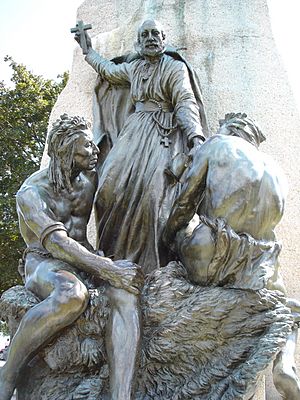
People have lived in the Orillia area for thousands of years. In the "Narrows," a small waterway between Lake Couchiching and Lake Simcoe, archaeologists found old fishing weirs. These were used by Huron and Iroquois people to catch fish over 4,000 years ago. Other sites nearby show that Indigenous people used the area for trading, fishing, and hunting for hundreds of years. The land where Orillia now stands was first a settlement of the Huron-Wendat people. Later, the Ojibwe people settled here under Chief William Yellowhead. The Ojibwe lived on this land until European settlers arrived.
The famous French explorer Samuel de Champlain visited this area in the summer of 1615. He traveled along what would later become Coldwater Road. This route was used by the Hurons, Ojibways, French, and British for fur trading. Champlain spent the winter with the Hurons in their main village, Cahiague. A local French elementary school, Ecole Samuel de Champlain, is named after him. You can also find a monument to Samuel de Champlain in Couchiching Beach Park. It is a National Historic Site of Canada.
The government made agreements with the Hurons in 1798, 1815, and 1818 to get land north and west of Lake Simcoe. Then, they gave land to military veterans. In 1840, the government bought more land from the First Nations. They then planned out the settlement of Orillia. By 1846, about 200 people lived there. The settlement had a church, a post office, four stores, and three taverns. It also had a tannery, two blacksmiths, four shoemakers, a tailor, and two furniture makers. A mill for grinding grain was about a mile away.
By 1869, the population grew to 1,200. The Monck Road was built between 1866 and 1873. This 100-mile road allowed travel to Bancroft, Ontario. From there, other roads led to Ottawa.
Better transportation links to Toronto and Georgian Bay helped Orillia grow. It became an important place for business and a summer vacation spot. Orillia became an official village in 1867, the same year Canada was formed. By 1875, with 2,000 people, Orillia became a town. It had a mayor and councillors. In 1969, Orillia was officially named a city.
In Stephen Leacock's 1912 book, Sunshine Sketches of a Little Town, Orillia was the inspiration for the made-up town called "Mariposa." Leacock said the town could be any town. The book was based on his time in Orillia. Since the book came out, the city has tried to be like the fictional Mariposa in many ways. The Leacock Museum and National Historic Site in Orillia is one of the National Historic Sites of Canada.
William E. Bell's 1989 novel Five Days of the Ghost also takes place in Orillia. Readers can recognize local places like the Guardian Angels Catholic Church and the Samuel de Champlain statue in Couchiching Beach Park. Chiefs Island in Lake Couchiching is also mentioned.
Orillia was the first city in North America to start using daylight saving time. It also had the first city-owned power plant that used water to make electricity in North America.
Why Orillia is Called Orillia
The name "Orillia" was first used in 1820. It was given by Sir Peregrine Maitland, who was the Lieutenant-Governor of Upper Canada (now Ontario). Maitland had fought in a war in Spain called the Peninsular War.
No clear records explain why the name Orillia was chosen. However, the most common idea is that it comes from the Spanish word "orilla." This word means the shore of a lake or river. The Spanish pronunciation sounds like "oreeya." Since the spelling is very similar, it is widely believed to be the source of the city's name. Other nearby places also have Spanish names. For example, Oro means "gold," Mariposa means "butterfly," and Mono means "monkey."
Population of Orillia
| Orillia Historical populations | ||
|---|---|---|
| Year | Pop. | ±% |
| 1841 | 200 | — |
| 1871 | 1,322 | +561.0% |
| 1881 | 2,911 | +120.2% |
| 1891 | 4,752 | +63.2% |
| 1901 | 4,907 | +3.3% |
| 1911 | 6,828 | +39.1% |
| 1921 | 8,774 | +28.5% |
| 1931 | 8,183 | −6.7% |
| 1941 | 9,705 | +18.6% |
| 1951 | 12,110 | +24.8% |
| 1961 | 15,345 | +26.7% |
| 1971 | 24,040 | +56.7% |
| 1981 | 23,955 | −0.4% |
| 1991 | 25,925 | +8.2% |
| 1996 | 27,846 | +7.4% |
| 2001 | 29,121 | +4.6% |
| 2006 | 30,259 | +3.9% |
| 2011 | 30,586 | +1.1% |
| 2016 | 31,166 | +1.9% |
| 2021 | 33,411 | +7.2% |
| Canada census – Orillia community profile | |||
|---|---|---|---|
| 2016 | 2011 | 2006 | |
| Population: | 31,166 (+1.9% from 2011) | 30,586 (+1.1% from 2006) | 30,259 (+3.9% from 2001) |
| Land area: | 28.58 km2 (11.03 sq mi) | 28.61 km2 (11.05 sq mi) | 28.61 km2 (11.05 sq mi) |
| Population density: | 1,090.3/km2 (2,824/sq mi) | 1,069.2/km2 (2,769/sq mi) | 1,057.8/km2 (2,740/sq mi) |
| Median age: | 47.0 (M: 44.4, F: 49.3) | 42.7 (M: 41.0, F: 44.2) | |
| Total private dwellings: | 14,287 | 13,863 | 13,013 |
| Median household income: | $55,802 | $46,722 | |
| References: 2016 2011 2006 earlier | |||
In the 2021 Census, Orillia had a population of 33,411 people. They lived in 14,422 homes. This was a 7.2% increase from its 2016 population of 31,166. The city covers a land area of 28.53 square kilometers (11.02 sq mi). This means about 1,171 people lived in each square kilometer in 2021.
Grape Island
Grape Island is an island in Lake Simcoe. It is located near Victoria Point, in the northern part of the lake.
Today, about 40 private homes or cottages are on the island. The people who own property there are part of the Grape Island Property Owners Association. Only island residents can access the island by boat. They use a dock on Forest Avenue South to get to their private docks on the island. There is a lot of boat traffic at the mainland docks. This has caused some problems between island residents and people living in Victoria Point. The city of Orillia is trying to find a way for people to reach the island without bothering Victoria Point residents.
There are no roads for cars on the island. Only Ivy Lane, a path, leads to the homes. Water taxis are the main way to get to the island. Residents can also use their own boats.
Orillia's Economy
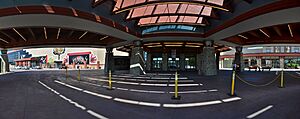
Long ago, fur traders were interested in Orillia. They used the "Narrows" as a meeting place to trade with many Indigenous tribes. Over time, Orillia's economy changed. It included farming, making machinery, and even building early "campers" (pop-up tents for cars).
Today, Orillia's economy is a mix of different jobs. These include manufacturing, government services, customer service, and tourism. The biggest employer nearby is Casino Rama. It is located on the reserve land of the Chippewas of Rama First Nation.
Factories in Orillia make many things. These include industrial heaters, industrial equipment, and parts for the petrochemical industry. They also make molded rubber products, parts for packaging, and aerospace parts. TI Group Automotive Systems makes car parts. Tele Tech Canada, a call center, also employs about 850 people. The main office for the Ontario Provincial Police (OPP) is in Orillia.
Some companies have closed in Orillia. Heywood-Wakefield seating closed in 2007. Parker Hannifin closed its operations in 2009.
G.W.B. Rope & Twine used to make braided rope. They also invented the cargo net for cars. This net was first used in the Ford Taurus car in 1985. The company was later sold and became Polytech Netting Industries. It employed hundreds of people before moving to Mexico in 1996–97. The founders of G.W.B. Rope and Twine started G&B Ropes in 1990. Later, Sean Brown, one of the founders' sons, helped start Orillia's newest rope-making business, Redpoint Ropes.
Large government employers include the headquarters for the Ontario Provincial Police. The Huronia Regional Centre was once a large employer. It was a place for people with disabilities. It closed in the 1980s and 1990s as people moved to live in smaller communities.
Fun and Culture in Orillia
Orillia is known as the "Sunshine City." This name comes from the book Sunshine Sketches of a Little Town by Stephen Leacock. In the book, Orillia is the fictional town of "Mariposa." Many local businesses use "Mariposa" in their names.
The city council wants to keep a "small town" look downtown. They have limited how big new buildings can be. In 2017, there were talks about improving the waterfront area. A 3D model was made to show how the area could look. It is on display at city hall.
Orillia's "Arts District" is on Peter St. S. Here you can find art galleries, nice restaurants, and shops. The Orillia Museum of Art & History is at the center of this district. It is a main place for art and culture in the city.
The museum is in the historic Sir Sam Steele Building. It has over 10,000 historical items from the region. These are shown in changing exhibits. Another floor has modern art from local and international artists. The museum also has a space for learning. It hosts activities like art-making and special programs for children and artists.
Many tourists and boaters visit Orillia each year. They come for the waterfront park, which includes Couchiching Beach Park, Centennial Park, and the Port of Orillia. The city is also a starting point for exploring Lake Country, Muskoka, Algonquin Provincial Park, and the Trent–Severn Waterway. The city's waterfront has a long boardwalk along the lake. There is a large park with two beaches, playgrounds, an outdoor theater, a ferry, and a children's train.
Orillia has many retirement homes. There are currently nine, with four more being built. Because of this, some people call it a "retirement community." However, less than 18% of the city's population is over 65.
Orillia hosts an annual Perch Fishing Festival. Fish are caught, tagged, and released into the lake. People can then catch them for prize money. This event also includes a big "perch fry" meal. Other popular yearly festivals include the Leacock Festival, Blues Festival, Jazz Festival, Scottish Festival, and Beatles Festival.
The Port of Orillia has an annual "Christmas in June" event. This includes a boat decorating contest and a turkey dinner. Boat and cottage shows are held in June and August.
Orillia also celebrates Canada Day at Couchiching Beach Park. The day starts with a pancake breakfast served by the Mayor. It ends with a big fireworks show at night.
Orillia was the first home of the popular Mariposa Folk Festival. It started in 1961 and is Canada's longest-running folk festival.
The Stephen Leacock Associates honor the humorist Stephen Leacock each year. Since 1947, they have given the Stephen Leacock Memorial Medal for Humour. This award goes to the best funny Canadian book published the year before. The award ceremony is held in June at Geneva Park.
The Royal Canadian Legion holds a yearly Scottish Festival. It takes place at Couchiching Beach Park and Centennial Park in July. Marching bands from all over the country take part.
Since 1963, the Webers hamburger restaurant has been just north of Orillia. It is next to Ontario Highway 11.
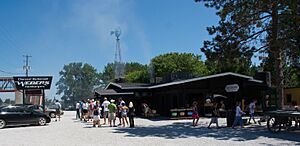
Lake St. George Golf Club is ten minutes north of Orillia.
Education in Orillia
Orillia offers both French and English public education.
There is one Catholic French-language elementary school called École élémentaire catholique Samuel-de-Champlain. Students from this school go to École secondaire catholique Nouvelle-Alliance in Barrie for high school.
English public education is provided by the Simcoe County District School Board. Orillia has nine elementary schools and three high schools. The high schools are Twin Lakes Secondary School and Orillia Secondary School. Orillia Secondary School was formed in 2013 by combining Orillia District Collegiate and Vocational Institute and Park Street Collegiate Institute. There is also an alternative high school called OASIS.
Publicly funded Catholic English-language education is available through the Simcoe Muskoka Catholic District School Board. They have four elementary schools and one high school, Patrick Fogarty Catholic Secondary School.
Private schools include the Orillia Christian School.
Orillia also has two colleges. The Orillia campus of Georgian College offers programs in applied arts and technology to 1,600 students. Lakehead University has a small campus downtown. Its main campus on University Ave. opened in 2010. The Lakehead University campus on University Avenue is special. It was the first in North America built to meet all LEED® (Leadership in Energy and Environmental Design) green building standards.
There is also an Adult Learning Centre. Adults can go there to finish their high school diplomas.
Getting Around Orillia
Orillia Transit provides bus service on five routes throughout the city. All these routes start and end at the downtown bus terminal. This terminal is at West and Mississaga Streets, near the Orillia Public Library and Opera House. Orillia Transit buses run from 6:15 a.m. to 10:15 p.m. on weekdays. They have shorter hours on weekends and do not run on holidays.
In August 2019, Simcoe County LINX started a bus route. This route connects Orillia with Barrie on weekdays.
Ontario Northland provides bus service between cities. You can travel from Orillia to Toronto, Barrie, North Bay, and Sudbury, among other places. The bus stop moved from the old train station to the Knights Inn on Front Street in 2020. In 2024, it moved again to the Orillia Transit terminal.
Orillia used to be a stop for the Northlander train. But the train route changed, and service stopped. The old train station is still there, but it is now used for businesses.
Environmental Efforts
In 2012, Orillia won a top award for its efforts to reduce waste. In 2011, the city recycled or composted 61% of its waste. The Recycling Council of Ontario gave the city its highest award, the Platinum Municipal Diversion Award.
Ontario Provincial Police Headquarters
The provincial government decided to move some of its services out of the main city. So, the headquarters of the Ontario Provincial Police (OPP) moved to Orillia. The office was first in the Tudhope Building downtown. Part of that building is now Orillia City Hall. The new headquarters opened in 1995. This building is called the Lincoln M. Alexander Building. It is on Memorial Avenue, near the Huronia Regional Centre. The building holds different departments of the OPP. It also has the Provincial Police Academy and The OPP Museum.
The OPP Central Region Headquarters is on Hurtubise Road. It is near the intersection of Highway 12 and Memorial Avenue.
The OPP also provides police services for the City of Orillia. They do this under a contract from a police station on University Avenue. Orillia's own police force was ended when this contract started in 1996.
Media
Radio
- FM 105.9 - CICX-FM "Pure Country 106", plays country music
- FM 89.1 - CISO-FM "MAX FM", plays Alternative and Rock music
- FM 98.5 - CIOA-FM - a station with tourist information
TV
You can watch TV stations from nearby areas in Orillia:
| OTA virtual channel (PSIP) | OTA channel | Rogers Cable | Call Sign | Network | Notes |
|---|---|---|---|---|---|
| 3.1 | 10 (VHF) | 5 | CKVR-DT | CTV 2 | Comes from Barrie |
| 7.1 | 7 (VHF) | 13 | CIII-DT-7 | Global | Comes from Midland; repeats CIII-DT-41 (Toronto) |
| – | 21 (UHF) | 8 | CFTO-TV-21 | CTV | Repeats CFTO-DT (Toronto) |
Rogers Cable is the main company that provides cable TV in Orillia.
Famous People from Orillia
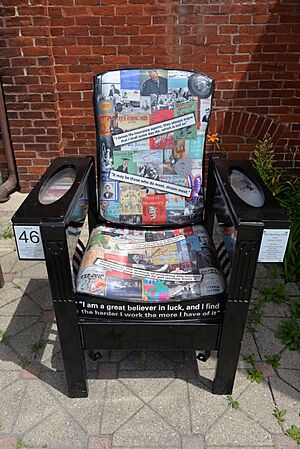
- A. Charles Baillie, former leader of Queen's University
- James Bartleman, a diplomat and former lieutenant governor of Ontario
- William E. Bell, an author
- Franklin Carmichael, one of the famous Group of Seven painters
- Leslie Frost, a former premier of Ontario
- Jake Gaudaur, a football player
- Jake Gaudaur Sr., a champion rower
- Walter Knox, an athlete and coach
- John Lawless, an ice hockey player in the British Ice Hockey Hall of Fame
- Stephen Leacock, a famous humorist and writer
- Gordon Lightfoot, a well-known singer and songwriter
- Ethan Moreau, a hockey player for the Columbus Blue Jackets
- Sam Steele, a soldier and member of the Royal Canadian Mounted Police
- Don Tapscott, a member of the Order of Canada
- Elizabeth Wyn Wood, a sculptor
See also
 In Spanish: Orillia para niños
In Spanish: Orillia para niños




